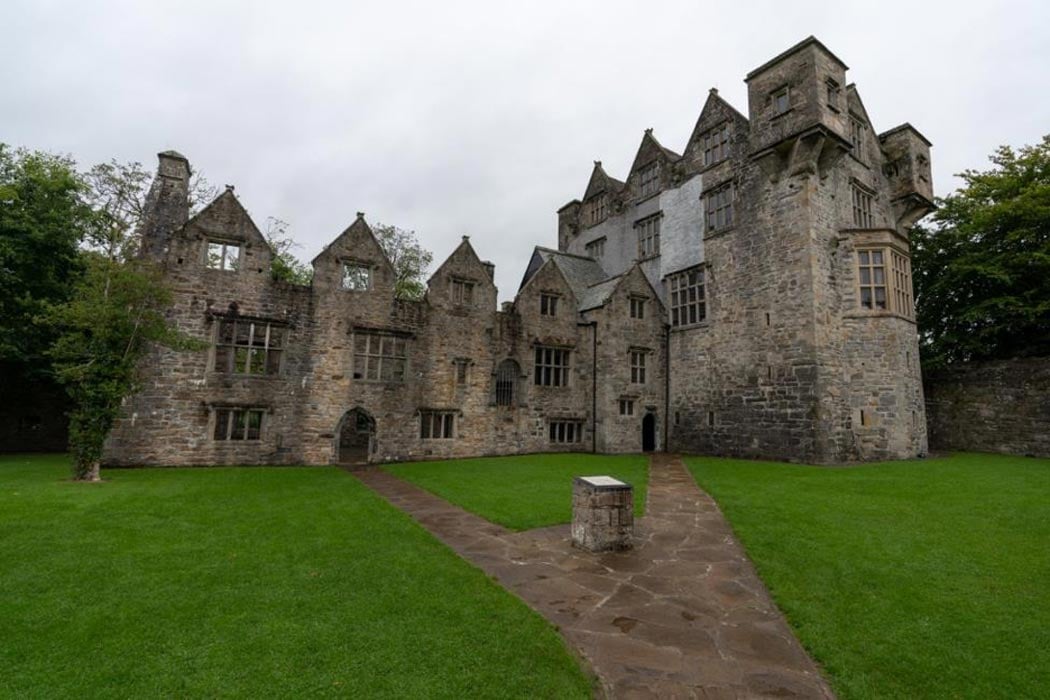Donegal Castle: Home of the O’Donnell Clan, Fort of the Foreigner, Captivating Gaelic Castle
Donegal Castle is a castle located in County Donegal, in the Irish province of Ulster. The castle dates to the 15th century, when it was constructed by the O’Donnell clan. The clan, however, lost Donegal Castle to the English during the 17th century. From the 18th century onwards, the castle was only intermittently occupied and gradually fell into ruins. It was only towards the end of the 20th century that restoration of Donegal Castle, or more precisely, the castle keep, began. The manor house has yet to be restored.

A section of Donegal Castle, which remains without a roof. Credit: Ioannis Syrigos
Early Donegal Castle History
Donegal Castle is situated in the center of Donegal Town, on a bend of the River Eske, near the mouth of Donegal Bay. The castle is considered one of Ireland’s finest Gaelic castles. During the 15th century, Donegal (which comes from the Irish Dhun na nGall, meaning ‘Fort of the Foreigner’) was the seat of power of the O’Donnell chieftains, hence its other name, ‘O’Donnell’s Castle’. It has been reckoned that the castle was built on the site of an old Viking fort, though there is currently no archaeological evidence to support this.
In 1474, the chief of the O’Donnell clan, Hugh O’Donnell, decided to build a castle in Donegal. The original castle had a rectangular keep, which still stands today. Hugh O’Donnell and his wife, Nuala, also built a Franciscan monastery further down the river. According to local folklore, a secret tunnel connects the two buildings, though there is no concrete evidence to support this tale. Over the centuries, the owners of Donegal Castle added to the structure, the most important addition being the manor house, which was constructed during the 17th century.
- Eilean Donan Castle: Idyllic Scottish Setting Carries a Dark History
- Blarney Castle: 1,000 Years of Dramatic History and THAT Magical Stone That Brings Tourists Flocking
- Who Killed the King? Was it Eochaid the Slayer? An Ancient Irish Murder Mystery

A model of Donegal castle showing what it once looked like. Credit: Ioannis Syrigos
Changes with the Nine Years’ War
The O’Donnells, however, only occupied Donegal Castle for about 140 years. During the 16th century, the Tudor Dynasty, which ruled over England at that time, commenced their conquest of Ireland. By the 1580s, the lands of the O’Donnells were being threatened by the English. The O’Donnell chief, Red Hugh O’Donnell, decided to form an alliance with an old enemy, the O’Neills, in order to fight the foreign invaders.
The Nine Years’ War (also known as Tyrone’s Rebellion) broke out in 1593. The Irish enjoyed some early success, capturing most of North Connaught, and defeating the English at the Battle of Clontibret and the Battle of the Yellow Ford. At the Battle of Kinsale in 1602, however, the Irish, in spite of the aid sent by the Spanish, were defeated by the English.

"The Gaelic Chieftain", a modern sculpture commemorating O'Donnell's victory at the battle at Curlew Pass in 1599. (Gavigan 01/CC BY SA 3.0)
The Nine Years’ War ended in 1603 with the defeat of the Irish. In 1607, Red Hugh O’Donnell, along with Hugh O’Neill, and about 90 of their followers, left Ireland for Spain, in what is known today as the Flight of the Earls.
New Donegal Castle Owners
In 1611, the English took control of the territories once owned by the O’Donnells, including Donegal and its castle. An English army captain by the name of Sir Basil Brooke was given the title Lord of Donegal, which included ownership of Donegal Castle. Prior to their departure from Ireland, the O’Donnells had severely damaged the castle’s keep. It was Brooke who made the repairs and added the manor house to the castle.

Magnificent fireplace bearing Brooke's coat of arms in ‘The Great Room’. Credit: Ioannis Syrigos
The Brooke family remained in Donegal for less than a century, after which they moved to Fermanagh. As a consequence, Donegal Castle began to fall into ruins during the 18th century. By the end of the 19th century, Donegal Castle was in the possession of the Earl of Arran. In 1898, the castle was donated by the earl to the Office of Public Works. It was, however, only a century later, during the 1990s, that the task of restoring Donegal Castle began.
- Fleckenstein Castle: From Impregnable Fortress to a Chateaux in Ruins
- The Rock of Dunamase: Vikings, Anglo-Norman Nobles, and Oliver Cromwell Paint the Castle’s History
- Clonmacnoise: Medieval Monastery Still Standing After 80 Attacks by the English, Irish, Vikings and Normans!

Inside ‘The Great Room’, where the fireplace is situated. Credit: Ioannis Syrigos
The Castle Today
The castle keep was almost completely restored, adding new roofing and floors using 15th and 17th century techniques and materials. Diorama displays inside the keep show what life was once like inside the castle.

Inside the manor house with restored roof. Credit: Ioannis Syrigos
Top image: Donegal Castle Credit: Ioannis Syrigos .
By Wu Mingren
References
Dempsey, J., 2018. Donegal Castle. Available at: http://www.megalithicireland.com/Donegal%20Castle.html
Donegal Diaspora Project, 2018. Donegal Castle. Available at: http://www.donegaldiaspora.ie/place/donegal-castle
www.britainirelandcastles.com, 2018. Castles of Ireland - Donegal Castle. Available at: http://www.britainirelandcastles.com/Ireland/County-Donegal/Donegal-Castle.html
www.discoveringireland.com, 2018. Donegal Castle.
Available at: https://www.discoveringireland.com/vacations/donegal-castle/
www.dochara.com, 2018. Donegal Castle. Available at: https://www.dochara.com/places-to-visit/castles/donegal-castle/
www.ourdonegal.com, 2018. Donegal Castle Tour. Available at: http://www.ourdonegal.com/donegal-castle.html
www.welovedonegal.com, 2018. Donegal Castle / O'Donnells Castle, Donegal Town. Available at: http://www.welovedonegal.com/donegal-castle.html



















